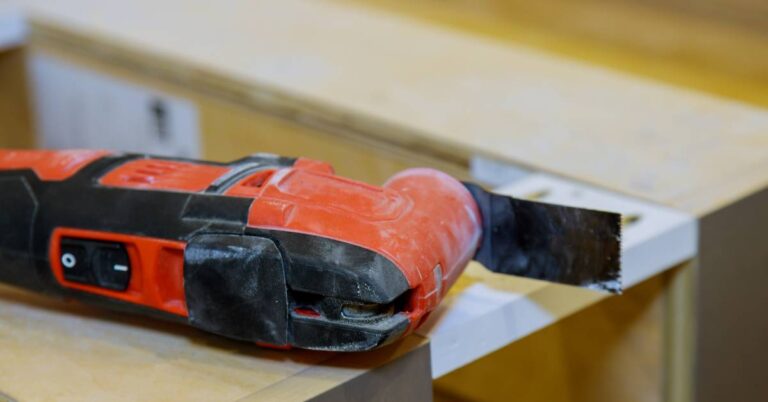Cutting Brick with Oscillating Tool: Fast and Precise Masonry Technique
Cutting brick with an oscillating tool can be a game-changer for DIY enthusiasts and professionals. This versatile power tool offers precision and control, allowing for clean cuts in tight spaces where traditional saws struggle to reach. With the correct blade attachment, oscillating tools can cut through brick, mortar, and other masonry materials.
The tool’s oscillating motion creates less dust and debris than circular saws or angle grinders, making it ideal for indoor projects. It’s beneficial for creating small openings in existing brickwork, such as electrical outlets or plumbing fixtures.
While oscillating tools excel at detail work and minor cuts, they may not be the best choice for large-scale brick-cutting projects. Proper technique and safety precautions are essential when using these tools on masonry to ensure clean cuts and prevent damage to the surrounding brickwork.
Key Takeaways
- Oscillating tools provide precise cuts in brick and masonry with minimal dust.
- Proper blade selection and safety measures are crucial for effective brick-cutting
- Regular maintenance and correct technique optimize tool performance and longevity.
Understanding the Oscillating Tool
Oscillating tools are versatile power tools that utilize rapid back-and-forth motion to cut, sand, and scrape various materials. Their compact size and interchangeable blades make them ideal for precision work in tight spaces.
Types of Oscillating Blades
Oscillating tool blades come in various shapes and sizes for different applications. Wood-cutting blades have teeth for efficient wood removal. Metal-cutting blades feature finer teeth for cutting metal and nails. Scraper blades help remove adhesives and old paint. Sanding pads are attached to the tool for smooth finishing.
Carbide-tipped blades offer increased durability for more challenging materials. Diamond-coated blades excel at cutting tile and masonry. Bi-metal blades combine the strength of high-speed steel with the flexibility of spring steel for versatile cutting performance.
Using Oscillating Tools for Different Materials
Oscillating tools excel at cutting brick when fitted with the appropriate diamond or carbide grit blade. The tool’s precise control allows for clean, straight cuts in masonry materials. For wood, a wood-cutting blade enables detailed cuts and plunge cuts in tight spots.
Select a bi-metal blade when cutting metal and use slower speeds to prevent overheating. Using sanding pad attachments, oscillating tools can sand wood, metal, and plastic surfaces. The tool’s compact size allows access to corners and edges that larger sanders can’t reach.
A carbide-grit blade offers the best performance for removing grout or cutting drywall. Its oscillating motion minimizes dust creation compared to rotary tools, making it ideal for indoor renovation work.
Preparation and Safety Measures
Proper preparation and safety measures are crucial when cutting brick with an oscillating tool. These steps help ensure precise cuts and protect the user from potential hazards.
Selecting the Right Blade
Choose a diamond-grit or carbide-grit blade specifically designed for masonry. These blades offer durability and efficiency when cutting through brick. Ensure the blade is compatible with your oscillating tool model.
Check the blade’s condition before use. Replace dull or damaged blades to maintain cutting accuracy and reduce the risk of injury.
Measure the cutting depth required for your project. Select a blade that can achieve this depth while allowing for proper tool control.
Safety Equipment and Precautions
Wear safety glasses to protect your eyes from flying debris. Goggles provide additional protection against dust and small particles.
Use a dust mask or respirator to prevent inhalation of brick dust. This is essential for maintaining respiratory health during the cutting process.
Wear heavy-duty work gloves to protect your hands from sharp edges and vibrations. Choose gloves that offer an excellent grip to maintain control of the tool.
Set up your work area in a well-ventilated space. If working indoors, use a dust extraction system to minimize airborne particles.
Secure the brick firmly before cutting. Use clamps or a sturdy workbench to prevent movement during the cutting process.
Professionals often use additional protective gear, such as ear protection and steel-toed boots, for enhanced safety during extended cutting sessions.
Cutting Brick and Concrete
Oscillating tools offer precise cutting capabilities for brick and concrete materials. Their versatility and control make them valuable for various masonry projects.
Achieving Precision Cuts with Oscillating Tools
Oscillating tools excel at making precise cuts in brick and concrete. For best results, use a segmented diamond blade designed for masonry. These blades feature high-grade diamond powder for efficient cutting.
Segmented blades allow for faster material removal and heat dissipation. Continuous rim blades provide smoother cuts but may require more time. Choose the appropriate blade based on the specific project requirements.
When cutting, maintain steady pressure and move the tool slowly. This approach ensures clean, accurate cuts without damaging the surrounding material. For deeper cuts, make multiple passes to avoid overheating the blade.
The Importance of Proper Technique
Proper technique is crucial for successful brick and concrete cutting. Start by clearly marking the cut line. Position the oscillating tool at a slight angle to the surface for better control.
Allow the tool to do the work – avoid applying excessive force. This approach prevents blade damage and ensures straighter cuts. Keep the blade cool by periodically pausing to let it rest.
For larger projects, consider using a dust extraction system. This reduces airborne particles and improves visibility. Wear appropriate safety gear, including eye protection and a dust mask.
Practice using scrap materials to refine your technique. With experience, users can achieve professional-quality cuts in brick and concrete using oscillating tools.
Tips for Optimal Use and Maintenance
Proper technique and regular maintenance are essential for getting the most out of your oscillating tool when cutting brick. These practices enhance performance and prolong equipment life.
Extending Blade Life
Use segmented diamond blades for cutting brick. These blades offer superior durability and cutting performance. Apply steady, moderate pressure when cutting to avoid overheating the blade.
Allow the tool to do the work – don’t force it. This prevents premature wear and ensures precise cuts. Take breaks during extended use to let the blade cool down.
Clean the blade after each use. Use a wire brush to remove brick dust and debris. This prevents buildup, which can reduce cutting efficiency.
Proper storage of blades when not in use is essential. They should be kept in a dry place to prevent rust and corrosion. For added protection, consider using blade guards.
Tool Care and Handling
Inspect the tool before each use. Check for loose parts or damage. Tighten any loose screws or fittings. Replace worn components promptly.
Keep the tool clean. Wipe it down after each use to remove brick dust. Pay special attention to vents and moving parts.
Lubricate moving parts regularly. Follow the manufacturer’s recommendations for proper lubrication intervals and products.
Store the tool in a dry, dust-free environment. Protect it from impacts and moisture with a case or toolbox.
Avoid dropping or mishandling the tool. Impacts can damage internal components and affect the oscillating motion.


